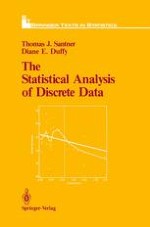1989 | OriginalPaper | Buchkapitel
Cross-Classified Data
verfasst von : Thomas J. Santner, Diane E. Duffy
Erschienen in: The Statistical Analysis of Discrete Data
Verlag: Springer New York
Enthalten in: Professional Book Archive
Aktivieren Sie unsere intelligente Suche, um passende Fachinhalte oder Patente zu finden.
Wählen Sie Textabschnitte aus um mit Künstlicher Intelligenz passenden Patente zu finden. powered by
Markieren Sie Textabschnitte, um KI-gestützt weitere passende Inhalte zu finden. powered by
This chapter describes the use of classical likelihood methods and loglinear models to analyze cross-classified data. Cross-classified data arise when a random sample W1, W2,…, Wm, say, is drawn from a discrete d-variate distribution where each trial Wk=(W1k,...,W d k)’ has common joint probability mass function: 4.1.1 $${p_i}: = P[W_1^k = {i_1}, \ldots ,W_d^k = {i_d}],$$ . Here the support of W j k is taken to be $$\{ 1, \ldots ,{L_j}\} $$ without loss of generality. The symbol W, without a superscript, will be used to denote a generic classification variable with probability mass function (4.1.1). By sufficiency, the data can be summarized as the counts $$\{ {Y_i}:i \in x\} $$ in a d-dimensional contingency table where Y i is the number of vectors W which equal i. Thus the counts $$\{ {Y_i}:i \in x\} $$ have the M t ( m, p ) multinomial distribution where $$p = \{ {p_i}:i \in X\} ,\sum\nolimits_{i \in x} {{p_i}} = 1,t = \Pi _{j = 1}^d{L_j},$$ , and $$m = \sum\nolimits_{i \in x} {{Y_{i\cdot }}} $$ .
